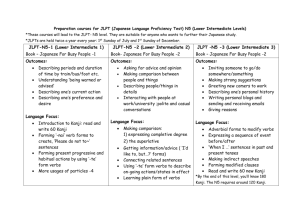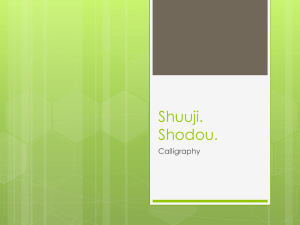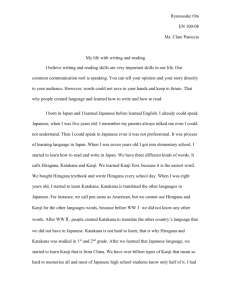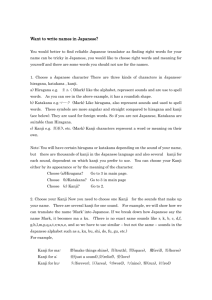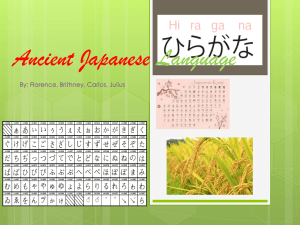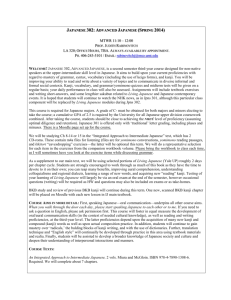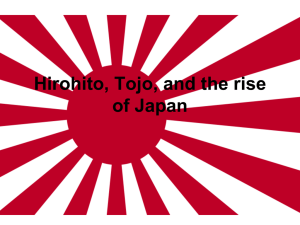Same as above, but with only NLP-relevant slides
advertisement
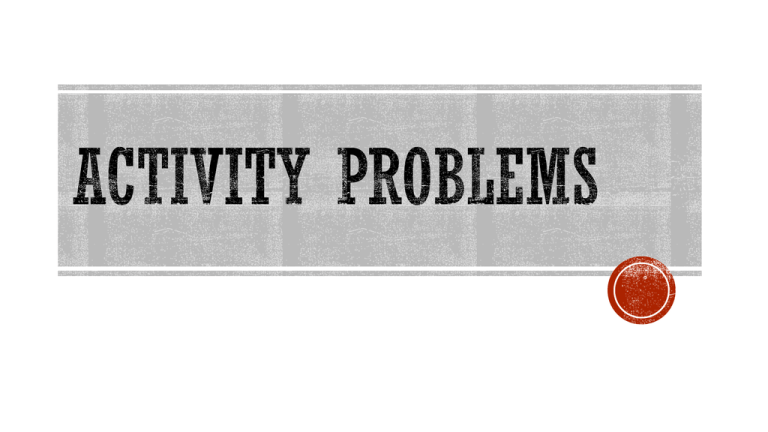
Here are some sentences in Hindi, a language spoken in India. Jute laal hain. The shoes are red Jute safed hain. The shoes are white. Kameez laal hai. The shirt is red. How would you say “The shirt is white” in Hindi? Phrase Alignment Jute The shoes Jute The shoes laal Phrase Translation hain The shirt are safed are red hain white is white laal The shirt is hai red Kameez hai safed Ordering Kameez Kameez How does Google Translate work? safed hai Here are some sentences in Hindi, a language spoken in India. Chai dijie. Tea, please. Roti dijie. Bread, please. Chawal dijie. Rice, please. How would you say “Water, please” in Hindi? Hint: ‘water’ = pani Here are some sentences in Hindi, a language spoken in India. Char matchliyan hain. There are four fish. Char ladkiyan hain. There are four girls. Che matchliyan hain. There are six fish. How would you say “There are six girls” in Hindi? Here are some sentences in Japanese. Just like in America, Japanese schools have many different levels. Emi wa chuugakusei desu. Emi is a middle school student. Ken wa daigakusei desu. Ken is a high school student. Sayuri wa shougakusei desu. Sayuri is an elementary school student. If the Japanese word for “I” is watashi, can you say what kind of student you are? Here are some sentences in Japanese. Ritsu wa hana ga suki desu. Ritsu likes flowers. Chihiro wa hana ga suki jyanai. Chihiro doesn’t like flowers. Asako wa ame ga suki desu. Asako doesn’t like candy. Can you figure out what this Japanese sentence means? Mizuho wa ame ga ski desu. Here are some sentences in Japanese. San ji desu. It is 3:00. Go ji han desu. It is 5:30. Roku ji desu. It is 6:00. You need to know what time it is, and your friend Erika just told you – in Japanese! Can you figure out what she said? “San ji han desu.” Here are some sentences in Spanish. El perro duerme. The dog sleeps. El perro come. The dog eats. El gato duerme. The cat sleeps. Can you figure out what this Spanish sentence means? El gato come. Japanese uses a system of letters known as kanji. Each kanji has a specific meaning and pronunciation(s), and kanji can be combined to make new meanings. 今 = “now” 日 = “day” What do you think 今日 means? Japanese uses a system of letters known as kanji. Each kanji has a specific meaning and pronunciation(s), and kanji can be combined to make new meanings. 中 = “middle” 学 = “school, learning” What do you think 中学 means? Japanese uses a system of letters known as kanji. Each kanji has a specific meaning and pronunciation(s), and kanji can be combined to make new meanings. 外 = “outside” 国 = “country” What do you think 外国 means? Japanese uses a system of letters known as kanji. Each kanji has a specific meaning and pronunciation(s), and kanji can be combined to make new meanings. 日本 = “Japan” 語 = “language” What do you think 日本語 means? Japanese uses a system of letters known as kanji. Each kanji has a specific meaning and pronunciation(s), and kanji can be combined to make new meanings. 食べ = “to eat” 物 = “thing” What do you think 食べ物 means? Fill in the blanks so that both phrases make sense! CREDIT _ _ _ _ GAME ICE _ _ _ _ _ CHEESE COUCH _ _ _ _ _ _ CHIP SPEECH RECOGNITION: WHICH SEQUENCES OF WORDS ARE MORE PROBABLE? How to recognize speech. How to wreck an ice peach. How to wreck a nice beach. I sent out a request to my colleagues for an example from a real speech recognition or MT system. Fill in the blanks so that both phrases make sense! BASEBALL _ _ _ CAVE POOL _ _ _ _ _ HAT BOOK _ _ _ _ _ UP Fill in the blanks so that both phrases make sense! MOVIE _ _ _ _ _ _ _ PARK AIR _ _ _ _ _ _ HERO ROCK _ _ _ _ GAZING Maori is a language spoken by the aboriginal (native) people of Australia. Some words in Maori, called loanwords, are “borrowed” from English. Can you match each loanword to its picture? tuuru A puutu wuuru B C puunu D Maori doesn’t have consonant clusters like “st” in “stool” or “cr” in “cream”. Maori consonants are p, t, k, h, m, n, r, ng, and wh. But there is “ch” on the next slide. Maori words can begin with “ng” as in “ngaa” which can mean “the (plural)” or “breath”. Some words in Japanese, called loanwords, are “borrowed” from English. Can you match each loanword to its picture? takushii A aisu kuriimu B pengin C chiizu D Maori is a language spoken by the aboriginal (native) people of Australia. Some words in Maori, called loanwords, are “borrowed” from English. Can you match each loanword to its picture? haama A haapa B waana C maati D Each of these newspaper headlines can have two different meanings! Can you figure out what they are? A. IRAQI HEAD SEEKS ARMS B. STOLEN PAINTING FOUND BY TREE C. KIDS MAKE HEALTHY SNACKS Ambiguity is combinatoric I saw a man in a park on a hill with a telescope? Professor Word has invented a machine to read the newspaper aloud, but it isn’t working right! This ad it just read doesn’t make any sense… “Do you love docks? We11 tick-tock, time is running out Sor dock wor1d’s spring sale! We have watches, grandSather docks, and so much more! Whether you are a dock co11ector or just buying one Sor Sun, stop by dock wor1d today!” Can you figure out which THREE MISTAKES the machine is making? Converts pictures of old books into searchable text. But it makes some mistakes. You are in ANNINO Station in Moscow, Russia. You need to get off at the “MITINO” stop. Can you figure out which train to board just by looking at these Russian signs? Hint: The sign for ANNINO is АННИНО in the Russian alphabet! 1 2 3 4 ПЕРОВО МИТИНО ОРЕХОВО МАРЬИНО Can you change BOB’S RAFTS to BARB’S CRAFTS in just FOUR moves?! Hint: one move = remove, add, or move a letter THIS IS HOW YOUR SPELL CHECKER WORKS! Thes is hou yur spel cheaker wurks. How many ways can you break this into words? Some languages like Chinese and Japanese are written without spaces. I’m waiting for a Chinese example from a student.
